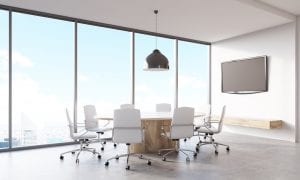In the past decade, technology companies have embraced the trend of open concept work spaces. Experts felt that the communal working atmosphere would foster collaboration, creativity, and transparency. Unfortunately, employees working in open-concept office environments aren’t embracing the trend and organizations are left scrambling to figure out how to fix this expensive cultural shift.
Today, studies on workplace design and employee productivity are showing that the open concept spaces can work effectively with the smart addition of multi-purpose, huddle rooms.
What is a huddle room?
Huddle rooms are small, private work spaces designed to accommodate working groups of four to six employees. They are generally equipped with all the bells and whistles of a standard conference room, including video conferencing equipment, whiteboards and other A/V equipment. Their purpose is to provide a space for co-workers to spontaneously meet up and brainstorm without distracting—or being distracted by— their peers.
6 Benefits of Huddle Rooms
Below we’ve come up with 6 benefits of huddle rooms and why your organization should consider them when discussing future office AV requirements or layouts.
1) Privacy enhances productivity
Compact huddle rooms allow for distraction-free, creative engagement among small working groups without productivity impact to their nearby peers.
Employees are more productive when insulated from visual and auditory distractions. According to a paper published by the Journal of Environmental Psychology, “the benefits of enhanced ‘ease of interaction’ were smaller than the penalties of increased noise level and decreased privacy resulting from open-plan office configuration.” This report is based on data from a study of more than 40,000 office workers in 300 U.S. office buildings.
We’re all familiar with transparency. As the term applies to employee productivity, the theory of transparency proposes that open floor plans in which workers are within eyesight of one another and their supervisors would remove an employee’s temptation to waste company time on personal calls, surfing the internet, or other productivity-killing activities.
Ethan Bernstein’s paper, The Transparency Paradox is another often-quoted study in which the author finds that privacy fosters productivity and collaboration, while open concept office or factory layouts can actually derail productivity by inducing privacy-seeking behaviors.
“Even a modest increase in group-level privacy sustainably and significantly improves line performance.” -Bernstein reports on his findings based on Chinese factory workers.
2) Less friction with improved workflow
Huddle rooms are designed for on-the-fly use, when and as needed. Their availability encourages employees to take advantage of inspiration and connectivity without the hurdles of setting appointments, and without disrupting the communal work environment.
How easy is it for your employees to connect with off-site collaborators? When you gather as a working group, do you have to hunt down your IT specialist to set up temporary conference equipment? How far out do you need to book your floor’s conference room? Days? Weeks?
There’s no second-guessing the feasibility of getting a team together when logistical barriers are removed. Just hop in a huddle room, push a couple buttons, and let the creative process begin.
3) Support for video conferencing and collaboration
Working groups favor live streaming and content sharing technology over e-mails, phone calls, and group teleconferences, and well-equipped huddle rooms facilitate efficient communication practices. Video conferencing enhances client and remote worker engagement, and dedicated huddle rooms encourage more frequent in-depth communication and enhanced customer care.
4) Flexible & cost effective implementation
Do you need a space to meet with a client? Does one of your teams need a “lab space” for a few days? Are you training new hires, or interviewing job candidates?
Huddle rooms allow for flexibility of use and are less expensive than traditional conference rooms! They take up less space and can make use of underutilized areas such as empty offices or storage areas.
5) Easier interaction with remote employees
Remote workers are more accessible when your company is set up for casual, spontaneous interaction. Given the increase in remote work arrangements among hired staff and outsourced talent, the rise in popularity of huddle rooms helps foster better relationships and teamwork among employees through increased access and face time.
Job candidates are demanding more flexibility with office hours, and research supports an increase in productivity among employees who work from home, as well as better employee retention and job satisfaction. Video conferencing and virtual work environments remove physical barriers to collaboration, allowing companies to build teams with contributing talent from anywhere in the world. When your company is set up to enhance and support employee interaction, you’re in a better position to attract and keep the best employees available, wherever they call home.
6) Enhanced customer experience
Imagine your key account management team speaking to your top customers from their cubicle in the middle of an open work space environment. The background noise and chatter can send the message that they are not important customers. Conversely, it can look awkward when your small team is stationed for a video call in a large boardroom. By right-sizing these meetings with appropriately sized huddle room set ups, your company earns customer trust through the reassurance of personalized, on-demand interaction and responsiveness.
Technology that supports transparency in key client management bolsters customer confidence and repeat business. Virtual interactions also allow your teams to resolve minor conflicts before they develop into issues requiring corporate travel agencies and disrupted workflows. This can also save clients from disrupting their own schedules for formal, in-person quarterly reviews.

Planning your huddle space
Whether your office layout is an open concept design or an old-school cubicle farm, it’s important to provide areas for small group collaboration.
Your investment in small group meeting and huddle rooms is a cost-saving step forward in enhancing your work environment and preparing your company for the future of collaborative communication. Huddle rooms foster inclusion, so why not include your employees in the design process? For the best results, encourage input and feedback and include their ideas when you’re working with your AV integrator and office designers.
Here are some questions to get you started:
- Do you need a separate space nearby each team – or can they share spaces in other areas?
- Do your audio-visual components need to be fixed or portable to best suit your needs?
- What types of enclosures (solid wall, glass) work best for your employee’s comfort levels?
- Are you willing to provide a variety of privacy levels for your teams?
Working with VSGi
As always, we’re here to help you design a meeting and collaboration space that fits your organizational needs. From huddle rooms to full-scale auditoriums and event spaces, we can help manage the end-to-end process and provide design, installation, and support. Contact us today using the form below to get started on your next project.
